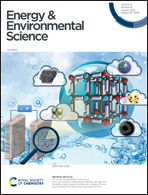Benchmark uranium extraction from seawater using an ionic macroporous metal–organic framework†
Abstract
Large-scale uranium extraction from seawater (UES) is widely considered as reconciliation to increasing global energy demand and climate change crises. However, an ideal uranium sorbent combining the features of high capacity, excellent selectivity, and ultra-fast kinetics is highly desirable but a long-standing challenge due to the lack of a proper adsorbent. Herein, we adopted a prototypal hybridization strategy to design a rare ionic macroporous metal–organic framework (MOF) decorated with multiple functional groups. The resulting ionic adsorbent captures 99.98% of the uranium in just 120 min (from ∼50 000 to ∼10 ppb) and offers a very large distribution coefficient, KUd > 107 mL g−1, demonstrating a strong affinity towards uranium. Notably, the material harvests 96.3% of uranium simply in 120 min from natural seawater, affording a remarkable enrichment index of 25044 and thereby introducing a new benchmark uranium adsorbent. Moreover, it satisfied the preset target of the UES standard (6 mg g−1) within 2 days and achieved a record uranium uptake capacity of 28.2 mg g−1 from natural seawater only in 25 days, which is a significant breakthrough in UES. The structural evidence from both experimental and theoretical studies confirmed that the formation of favourable chelating motifs into the ionic macropores governs the highly selective recovery of uranium from water.



 Please wait while we load your content...
Please wait while we load your content...